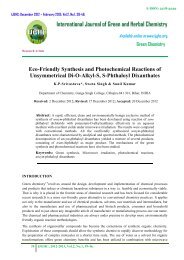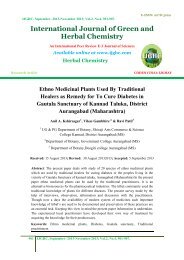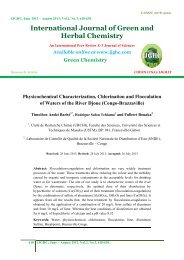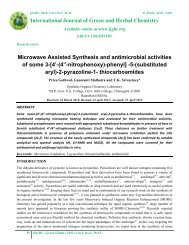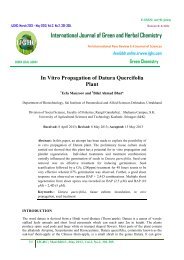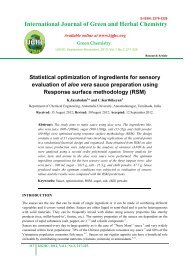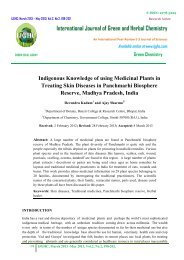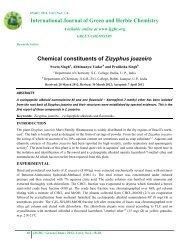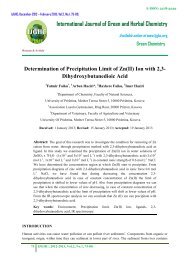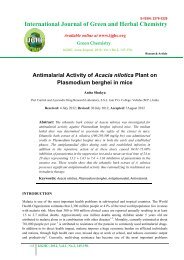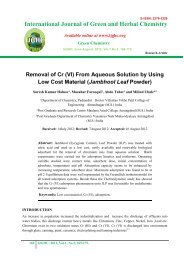Green 41. Ferric sulfate an Efficient Catalyst for the ... - IJGHC
Green 41. Ferric sulfate an Efficient Catalyst for the ... - IJGHC
Green 41. Ferric sulfate an Efficient Catalyst for the ... - IJGHC
Create successful ePaper yourself
Turn your PDF publications into a flip-book with our unique Google optimized e-Paper software.
E-ISSN: 2278-3229<br />
International Journal of <strong>Green</strong> <strong>an</strong>d Herbal Chemistry<br />
Available online at www.ijghc.org<br />
Herbal Chemistry<br />
<strong>IJGHC</strong>; September-November, 2012; Vol.1.No.3, 382-387.<br />
Research paper<br />
<strong>Ferric</strong> <strong>sulfate</strong> <strong>an</strong> <strong>Efficient</strong> <strong>Catalyst</strong> <strong>for</strong> <strong>the</strong><br />
Syn<strong>the</strong>sis of Imine under Solvent Free Condition<br />
Pramod Kulkarni*, Moh<strong>an</strong> Bhujbal, Yogesh Kad <strong>an</strong>d Dipak Bhosale<br />
Department of Chemistry, Hutatma Rajguru Mahavidyalaya Rajgurunagar Pune<br />
(Maharastra) India<br />
Received: 16 September 2012; Revised: 31 October 2012 Accepted: 9 November 2012<br />
Abstract: Anhydrous ferric <strong>sulfate</strong> has been found to be <strong>an</strong> efficient catalyst <strong>for</strong><br />
<strong>the</strong> syn<strong>the</strong>sis of imines. The reaction proceeds in high yields at ambient temperature<br />
<strong>an</strong>d in short time. The reaction has been studied with a variety of carbonyl<br />
compounds <strong>an</strong>d amines.<br />
Keywords: Imine, <strong>Ferric</strong> <strong>sulfate</strong>, Amines, Carbonyl, Solvent free<br />
INTRODUCTION<br />
The nitrogen atom is present in m<strong>an</strong>y natural products, biologically import<strong>an</strong>t molecules, pharmaceuticals<br />
<strong>an</strong>d dyes 1 . The condensation of amines with carbonyl compounds is a venerable <strong>an</strong>d useful org<strong>an</strong>ic<br />
tr<strong>an</strong>s<strong>for</strong>mation 2 as <strong>the</strong> result<strong>an</strong>t imines are used as multifaceted components in nucleophillic addition with<br />
org<strong>an</strong>ometallic reagents 3 , in cylcoaddition reactions 4 <strong>an</strong>d have potential <strong>for</strong> <strong>the</strong>rapeutic application such as<br />
lipoxygenase inhibitors, <strong>an</strong>ti inflammatory agents 5 <strong>an</strong>d <strong>an</strong>tic<strong>an</strong>cer agents 6 .<br />
Several methods <strong>for</strong> <strong>the</strong> syn<strong>the</strong>sis of imines are described in <strong>the</strong> literature; <strong>the</strong>y c<strong>an</strong> be obtained from<br />
aldehydes 7 , gem-dibromomethylaryl derivateives 8 , <strong>for</strong>mamides 9 <strong>an</strong>d by palladium catalyzed amination 10 .<br />
However, <strong>the</strong>se methodologies often require complex procedures, long reaction times <strong>an</strong>d large qu<strong>an</strong>tities<br />
of aromatic solvents. Various syn<strong>the</strong>tic routes <strong>for</strong> <strong>the</strong> syn<strong>the</strong>sis of imines are depicted in scheme-1 22 As<br />
nucleophilic attack by <strong>the</strong> amine at <strong>the</strong> carbonyl carbon in <strong>the</strong> first step is reversible, <strong>the</strong> feasibility of<br />
imine <strong>for</strong>mation largely depends on <strong>the</strong> rate of removal of water in <strong>the</strong> final step (route A). The classical<br />
syn<strong>the</strong>sis of imines, originally reported by Schiff 11 involves condensation of a carbonyl compound with <strong>an</strong><br />
382 <strong>IJGHC</strong>; 2012, Vol.1, No.3, 374-382-387.
<strong>Ferric</strong> Sulphate...<br />
Pramod Kulkarni et al.<br />
amine under azeotropic distillation to separate <strong>the</strong> liberated water 12 ; its subsequent removal was facilitated<br />
by <strong>the</strong> use of molecular sieves 13 . Recently <strong>an</strong> in situ dehydration strategy has been adopted by <strong>the</strong> use of<br />
dehydration solvents such as tetramethyl orthosilicate 14 <strong>an</strong>d trimethyl orthofomate 15 . In <strong>an</strong> alternative<br />
approach (route B), <strong>the</strong> condensation reaction has been carried out in <strong>the</strong> presence of ZnCl 16 2 , TiCl 17 4 ,<br />
MgSO 4 –PPTS 18 , alumina 19 , K-10 under microwave irradiation 18, 21 , Ti (OR) 19 4 which act as Lewis acids to<br />
catalyze nucleophilic attack on <strong>the</strong> carbonyl group by <strong>the</strong> amine as well as serve as dehydrating agents to<br />
facilitate <strong>the</strong> removal of water in <strong>the</strong> final step. Chakraborti et.al. reported <strong>the</strong> syn<strong>the</strong>sis of imines using<br />
magnesium perchlorate as <strong>the</strong> catalyst with reaction times r<strong>an</strong>ging from 15 to 480 min. 22.<br />
Route A:<br />
R 1<br />
OH R 3 R 1 R 2<br />
O H 2 N R 3<br />
R 1 NH<br />
N<br />
R 2 R 2<br />
R 2<br />
R 1<br />
R 2<br />
Route B:<br />
LA<br />
O<br />
R<br />
OH<br />
1<br />
R<br />
LA H 2 N-R 3<br />
3<br />
O<br />
R 1 NH<br />
R 2 R 2<br />
LAO<br />
R 1<br />
R 2<br />
N<br />
R 2<br />
H 2 O<br />
H<br />
R 1<br />
LA<br />
O R 3<br />
NH<br />
R 2<br />
383 <strong>IJGHC</strong>; 2012, Vol.1, No.3, 382-387.<br />
Scheme 1: Routes <strong>for</strong> syn<strong>the</strong>sis of imines<br />
The methodologies reported to have disadv<strong>an</strong>tages in terms of high reaction temperatures, prolonged<br />
reaction periods, <strong>an</strong>d excess of expensive dehydrating reagents/catalysts, moisture sensitive catalysts, <strong>an</strong>d<br />
special apparatus. Moreover, <strong>the</strong> efficiency of <strong>the</strong> procedures reported is limited to <strong>the</strong> reaction of highly<br />
electrophilic carbonyl compounds <strong>an</strong>d strongly nucleophilic amines.<br />
<strong>Ferric</strong> <strong>sulfate</strong> is inexpensive, non-toxic to <strong>the</strong> environment <strong>an</strong>d easily available. <strong>Ferric</strong> <strong>sulfate</strong> is used as<br />
efficiently Lewis acid in Knoevenagel condensation 23 , <strong>the</strong> Ferrier reaction of per-O-acetylated/benzylated<br />
glitches with alcohols to give 2,3-unsaturated -glycosides in a few minutes under microwave irradiation 24<br />
<strong>an</strong> efficient heterogeneous catalyst <strong>for</strong> <strong>the</strong> tetrahydropyr<strong>an</strong>ylation of alcohols <strong>an</strong>d phenols at ambient or<br />
near ambient temperature 25 . Here we report <strong>an</strong> efficient, practical environmentally benign <strong>an</strong>d high<br />
yielding method <strong>for</strong> <strong>the</strong> syn<strong>the</strong>sis of imines using <strong>Ferric</strong> <strong>sulfate</strong> as catalyst.<br />
EXPERIMENTAL<br />
All purchased chemicals were of <strong>an</strong>alytical grade <strong>an</strong>d used without fur<strong>the</strong>r purification. The 1 H NMR<br />
spectra were obtained on a Bruker DRX-300 Av<strong>an</strong>ce instrument using CDCl 3 as solvent <strong>an</strong>d TMS as<br />
internal st<strong>an</strong>dard at 300MHz. All products are known compounds; <strong>the</strong>ir physical <strong>an</strong>d spectroscopic data<br />
were compared with those reported in <strong>the</strong> literature <strong>an</strong>d found to be identical.<br />
Typical Procedure <strong>for</strong> imine <strong>for</strong>mation: A mixture of Substituted benzaldehyde (1mmole) Or Indole 3-<br />
Formaldehyde (1mmole), Substituted <strong>an</strong>iline (1 mmole) <strong>an</strong>d ferric <strong>sulfate</strong> (0.5mmol) was heated in neat
<strong>Ferric</strong> Sulphate...<br />
Pramod Kulkarni et al.<br />
condition at 50 o C <strong>for</strong> 2-3 hrs. Progress of <strong>the</strong> reaction was monitored by TLC. After completion of <strong>the</strong><br />
reaction, ice cold water was added into <strong>the</strong> reaction mixture, solid is precipitated out, filtered on Buckner<br />
funnel washed with water <strong>an</strong>d ice cold eth<strong>an</strong>ol.<br />
RESULTS AND DISCUSSION<br />
We thought that <strong>the</strong> condensation between a carbonyl compound <strong>an</strong>d <strong>an</strong> amine leading to <strong>the</strong> <strong>for</strong>mation of<br />
<strong>an</strong> imine should be a facile reaction due to <strong>the</strong> good electrophilic <strong>an</strong>d nucleophillic properties of <strong>the</strong><br />
carbonyl <strong>an</strong>d amine groups, respectively, <strong>an</strong>d may not require <strong>an</strong>y catalytic assist<strong>an</strong>ce in <strong>the</strong> absence of<br />
electronic factors. But when <strong>the</strong> electrophilicity of <strong>the</strong> carbonyl <strong>an</strong>d nucleophilicty amino groups might be<br />
decreases require catalyst <strong>for</strong> <strong>the</strong> condensation of carbonyl <strong>an</strong>d <strong>an</strong> amino group. <strong>Ferric</strong> <strong>sulfate</strong> is used as<br />
efficiently Lewis acid in m<strong>an</strong>y org<strong>an</strong>ic tr<strong>an</strong>s<strong>for</strong>mations. <strong>Ferric</strong> <strong>sulfate</strong> co-ordinate with carbonyl oxygen<br />
<strong>an</strong>d increase <strong>the</strong> electrophilicity of <strong>the</strong> carbonyl group <strong>an</strong>d facilitate <strong>the</strong> nucleophilic attack of amine on<br />
carbonyl <strong>an</strong>d serve as dehydrating agents to facilitate <strong>the</strong> removal of water in <strong>the</strong> final step.<br />
To establish <strong>the</strong> scope <strong>an</strong>d limitations of <strong>Ferric</strong> <strong>sulfate</strong> as a catalyst <strong>for</strong> imine <strong>for</strong>mation, structurally<br />
diverse carbonyl compounds were treated with different amines such as <strong>an</strong>iline, 4-chloro<strong>an</strong>iline, 4-<br />
nitro<strong>an</strong>iline under <strong>the</strong> catalytic influence of <strong>Ferric</strong> Sulphate <strong>an</strong>d <strong>the</strong> results are summarized in table1.<br />
Excellent results are obtained in most cases.<br />
R 1<br />
R<br />
CHO<br />
NH 2<br />
1 2<br />
R 1 Fe 2 (SO 4 ) 3<br />
Neat, heat<br />
R<br />
3<br />
Scheme 2: Syn<strong>the</strong>sis of imines catalyzed by <strong>Ferric</strong> <strong>sulfate</strong><br />
under solvent free condition<br />
Table-1: <strong>Ferric</strong> <strong>sulfate</strong> catalyzed syn<strong>the</strong>sis of imines<br />
Sr.<br />
No.<br />
Aldehyde R Amine R 1 Product Yield b<br />
(%)<br />
1. CHO<br />
90<br />
2.<br />
Cl<br />
HN<br />
N<br />
96<br />
3.<br />
HN<br />
N<br />
OMe<br />
98<br />
384 <strong>IJGHC</strong>; 2012, Vol.1, No.3, 382-387.
<strong>Ferric</strong> Sulphate...<br />
Pramod Kulkarni et al.<br />
4. NH 2<br />
NO 2<br />
96<br />
HN<br />
N<br />
5.<br />
NO 2<br />
92<br />
HN<br />
N<br />
6. NH 2<br />
MeO<br />
N<br />
NO 2<br />
82<br />
7.<br />
NO 2<br />
MeO<br />
N<br />
Cl<br />
92<br />
8. CHO<br />
NH 2<br />
92<br />
OMe<br />
OMe<br />
9. CHO<br />
NO 2<br />
90<br />
OMe<br />
OMe<br />
10.<br />
91<br />
11.<br />
MeO<br />
N<br />
88<br />
12 CHO NH 2<br />
N NO 2<br />
85<br />
13 CHO<br />
HO<br />
NO 2<br />
NH 2<br />
83<br />
NO 2<br />
385 <strong>IJGHC</strong>; 2012, Vol.1, No.3, 382-387.
<strong>Ferric</strong> Sulphate...<br />
Pramod Kulkarni et al.<br />
14 NH 2<br />
HO<br />
N NO<br />
82<br />
2<br />
NO 2<br />
15 NH 2<br />
89<br />
16<br />
NO 2<br />
87<br />
b: isolated yield<br />
CONCLUSION<br />
In summary, <strong>the</strong> present procedure <strong>for</strong> use of ferric <strong>sulfate</strong> as <strong>an</strong> efficient catalyst <strong>for</strong> syn<strong>the</strong>sis of imines<br />
offers adv<strong>an</strong>tage in terms of inexpensive <strong>an</strong>d easily available catalyst, condensation of deactivated amines<br />
<strong>an</strong>d carbonyl compounds to af<strong>for</strong>d imines in high yields compared to reported methods, reaction conditions<br />
<strong>an</strong>d work up procedure are mild <strong>an</strong>d easy to h<strong>an</strong>dle <strong>an</strong>d avoid <strong>the</strong> use of org<strong>an</strong>ic solvent. The present ecofriendly<br />
procedure represents <strong>an</strong> alternative to <strong>the</strong> existing methods <strong>for</strong> syn<strong>the</strong>sis of imines.<br />
ACKNOWLEDGEMENTS<br />
One of <strong>the</strong> authors PSK th<strong>an</strong>ks to BCUD Pune University <strong>for</strong> fin<strong>an</strong>cial assist<strong>an</strong>ce <strong>an</strong>d Principal H.R.M.<br />
Rajgurunagar <strong>for</strong> providing Laboratory Space to carry out this work.<br />
REFERENCE<br />
1. G. Thomas, IN Med. Chem., Wiley: New York, 2000.<br />
2. For a treatise on <strong>the</strong> chemistry of imines, see: (a) R. W. Layer, Chem. Rev. 1963, 63, 489-510; (b)<br />
S. Patai, In <strong>the</strong> Chemistry of <strong>the</strong> Carbon-Nitrogen Double Bond, Wiley Interscience, New York,<br />
1970.<br />
3. V. V. Kuznetsov, A. R. Pal’ma, A. E. Aliev, A.V. Varlamov, N.S. Prostakov, Zh. Org. Khim.<br />
1991, 127, 1579-1581 <strong>an</strong>d references cited <strong>the</strong>rein.<br />
4. (a) O. Tsuge, R. K<strong>an</strong>emasa, Adv. Heterocycl. Chem. 1989, 45, 231- 349; (b) M. F. Aly, M.I.<br />
Younes, S. A. O. Matwally, Tetrahedron 1994, 50, 3159-3168.<br />
5. D. J. Hadjipavlou-litina, A. A. Geronikaki, Drug Des. Discove. 1996, 15, 199-206.<br />
6. (a) M. Cushm<strong>an</strong>, D. Nagarathnam, D. Gopal, A.K. Chakraborti, C.M. Lin, E.J. Hamel, J. Med.<br />
Chem. 1991, 34, 2579-2588; (b) M. Cushm<strong>an</strong>, H.-M. He, C. M. Lin, E. J. Hamel, J. Med. Chem.<br />
1993, 36, 2817-2821; (c) P. Vicini, A. Geronikaki, M. Incerti, B.Busonera, G. Poni, C. A.Cabras,<br />
P. L. Colla, Bioorg. Med. Chem.,2003, 11, 4785-4789.<br />
7. (a) A. Simion, C. Simion, T. K<strong>an</strong>da, S. Nagashima, Y. MItoma, T.Yamada, K. Mimura, M.<br />
Tashiro, J. Chem. Soc., Perkin Tr<strong>an</strong>s.,2001, 1, 2071-2078; (b) R. B. Moffett, In Org<strong>an</strong>ic Syn<strong>the</strong>sis;<br />
N.Rabjohn, Ed.; John Wiley & Sons: New York, 1963, Coll. Vol. 4p 605; (c) P. Margareth, C.<br />
Schorder, S. Wolf, W.C. Agosta J.Org. Chem. 1983, 48, 1925-1926.<br />
8. N. Weibel, L. J. Charbonniere, R. F. Ziessel J. Org. Chem. 2002, 48, 7876- 7879.<br />
9. B. L. Feringa, J. J<strong>an</strong>sen, Syn<strong>the</strong>sis 1988, 184 -186.<br />
386 <strong>IJGHC</strong>; 2012, Vol.1, No.3, 382-387.
<strong>Ferric</strong> Sulphate...<br />
Pramod Kulkarni et al.<br />
10. (a) J. Barluenaga, F. Aznar, C. Valdes, Angew. Chem., Int. Ed. 2004, 43, 343-345; (b) J.<br />
Barluenga, C. Valdes, Chem. Commun.2005, 4891-4901.<br />
11. H.Schiff, Annals 1864, 131, 118.<br />
12. (a) R. Annunziata, M. Benaglia, M. Cinquini, F. Cozzi, Eur. J.Org. Chem. 2002, 1184-1190; (b)<br />
V. Molteni, R. Annuziata,M. Cinquini, F. Cozzi, M. Benaglia, Tetrahedron Lett. 1998,39, 1257-<br />
1260; (c) R.S. Varma, R. Dahiya, Synlett 1997, 1245-1246.<br />
13. K. Taguchi, F. H. Wesheimer, J. Org. Chem. 1971, 36, 1570-1572<br />
14. B. E. Love, J. Ren, J. Org. Chem. 1993, 58, 556-559 .<br />
15. (a) G. C. Look, M. M. Murphy, D. A. Campbell, M. A. Gallop, Tetrahedron Lett. 1995, 36, 2937-<br />
2940; (b) R. S. Vaas, J. Dudás, R. S. Varma, Tetrahedron Lett. 1999, 40, 4951- 4954<br />
16. J. H. Billm<strong>an</strong>, K. M. Tai, J. Org. Chem. 1958, 23, 535-539.<br />
17. (a) W. A. White, H. Weingarten, J. Org. Chem. 1967, 32, 213-214; (b) H. Weingarten, J. P.<br />
Chupp, W. A. White, J. Org. Chem. 1967, 32, 3246-3249; (c) I. Moretti, G. Torre, Syn<strong>the</strong>sis<br />
1970,141 ; (d) W. B. Jennigs, C. J. Lovely, Tetrahedron Lett. 1988, 29, 3725-3728; (e) F. Texier-<br />
Boullet, Syn<strong>the</strong>sis 1986, 679-681.<br />
18. B. P. Br<strong>an</strong>chaud, J. Org. Chem. 1983, 48, 3531-3538<br />
19. R. S. Vaas, J. Dudás, R. S. Varma, Tetrahedron Lett. 1999, 40, 4951- 4954.<br />
20. R. S. Varma, R. Dahiya, S. Kumar, Tetrahedron Lett. 1997, 38, 2039- 2042.<br />
21. (a) J. D. Armstrong, C. N. Wolfe, J. L. Keller, J. Lynch, M.Bhupathy, R. P. Vol<strong>an</strong>te, Tetrahedron<br />
Lett. 1997, 36, 1531-1532 ; (b) G. Liu, D. A. Cog<strong>an</strong>, T. D. Owens, T. P. T<strong>an</strong>g, J.A. Ellm<strong>an</strong>, J. Org.<br />
Chem. 1999, 64, 1278-1284.<br />
22. A. K. Chakraborti, S. Bagat, S. Rudrawar, Tetrahedron Lett.2004, 45, 7641-7644.<br />
23. C. Gill, G. P<strong>an</strong>dhare, R. Raut, V. Gore, S. Gholap Bulletin of <strong>the</strong> Catalysis Society of India 2008,<br />
7, 153-157 .<br />
24. Guisheng Zh<strong>an</strong>g, Qingfeng Liu Syn<strong>the</strong>tic Communications 2007, 37, 3485-3492.<br />
25. Lingjun Li, Lizhi Zhu, Xinying Zh<strong>an</strong>g, Guisheng Zh<strong>an</strong>g, Guirong Qu C<strong>an</strong>. J. Chem. 2005, 83,<br />
1120-1123.<br />
*Correspondence Author: Pramod Kulkarni;<br />
Department of Chemistry, Hutatma Rajguru Mahavidyalaya Rajgurunagar Pune,<br />
Maharastra, India<br />
387 <strong>IJGHC</strong>; 2012, Vol.1, No.3, 382-387.



